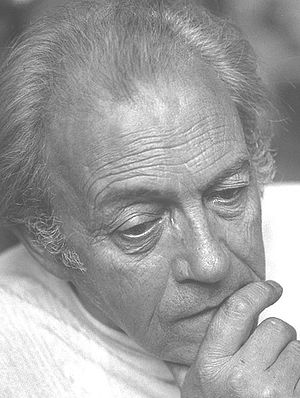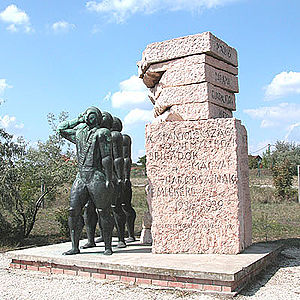
Memos Makris
Encyclopedia


Patras
Patras , ) is Greece's third largest urban area and the regional capital of West Greece, located in northern Peloponnese, 215 kilometers west of Athens...
– died May 26 1993 in Athens
Athens
Athens , is the capital and largest city of Greece. Athens dominates the Attica region and is one of the world's oldest cities, as its recorded history spans around 3,400 years. Classical Athens was a powerful city-state...
) was a prominent Greek sculptor. He spent his early childhood in Patras
Patras
Patras , ) is Greece's third largest urban area and the regional capital of West Greece, located in northern Peloponnese, 215 kilometers west of Athens...
but his family moved to Athens in 1919. He studied at the Athens School of Fine Arts
Athens School of Fine Arts
The Athens School of Fine Arts , is Greece's premier art school whose main objective is to develop the artistic talents of its students.-History:Athens School of Fine Arts was established on 12 January 1837, known as the School for the Arts...
and soon became involved in the artistic and cultural life of the 1930s. During the German Occupation Makris joined the National Resistance
Greek Resistance
The Greek Resistance is the blanket term for a number of armed and unarmed groups from across the political spectrum that resisted the Axis Occupation of Greece in the period 1941–1944, during World War II.-Origins:...
. After the liberation he continued his studies in Paris. He was deported from France in 1950 due to his political allegiance to the Left and sought political asylum
Right of asylum
Right of asylum is an ancient juridical notion, under which a person persecuted for political opinions or religious beliefs in his or her own country may be protected by another sovereign authority, a foreign country, or church sanctuaries...
in Hungary
Hungary
Hungary , officially the Republic of Hungary , is a landlocked country in Central Europe. It is situated in the Carpathian Basin and is bordered by Slovakia to the north, Ukraine and Romania to the east, Serbia and Croatia to the south, Slovenia to the southwest and Austria to the west. The...
. In Hungary he became an important figure in the country's political and cultural life. In 1964 he was deprived of his Greek nationality, which he regained in 1975 after the restoration of democracy in Greece. In 1979 his first retrospective exhibition in Greece took place in the National Art Gallery.
Important works
Some of his monumental sculptures include the one dedicated to the victims of the MauthausenMauthausen-Gusen concentration camp
Mauthausen Concentration Camp grew to become a large group of Nazi concentration camps that was built around the villages of Mauthausen and Gusen in Upper Austria, roughly east of the city of Linz.Initially a single camp at Mauthausen, it expanded over time and by the summer of 1940, the...
concentration camp
Internment
Internment is the imprisonment or confinement of people, commonly in large groups, without trial. The Oxford English Dictionary gives the meaning as: "The action of 'interning'; confinement within the limits of a country or place." Most modern usage is about individuals, and there is a distinction...
in Austria
Austria
Austria , officially the Republic of Austria , is a landlocked country of roughly 8.4 million people in Central Europe. It is bordered by the Czech Republic and Germany to the north, Slovakia and Hungary to the east, Slovenia and Italy to the south, and Switzerland and Liechtenstein to the...
, the monument to the Hungarian volunteers of the Spanish Civil War in Budapest
Budapest
Budapest is the capital of Hungary. As the largest city of Hungary, it is the country's principal political, cultural, commercial, industrial, and transportation centre. In 2011, Budapest had 1,733,685 inhabitants, down from its 1989 peak of 2,113,645 due to suburbanization. The Budapest Commuter...
, the monument of Liberation in Pécs
Pécs
Pécs is the fifth largest city of Hungary, located on the slopes of the Mecsek mountains in the south-west of the country, close to its border with Croatia. It is the administrative and economical centre of Baranya county...
. Many other of his works adorn squares and buildings all over Hungary. In Greece he is most known for his sculpture of the head of a youngster that is located at the entrance of the NTUA
National Technical University of Athens
The National Technical University of Athens , sometimes simply known as Athens Polytechnic, is among the oldest and most prestigious higher education institutions of Greece....
commemorating the 1973 Athens Polytechnic uprising
Athens Polytechnic uprising
The Athens Polytechnic uprising in 1973 was a massive demonstration of popular rejection of the Greek military junta of 1967-1974. The uprising began on November 14, 1973, escalated to an open anti-junta, anti-US and anti-imperialist revolt and ended in bloodshed in the early morning of November...
, and in Cyprus
Cyprus
Cyprus , officially the Republic of Cyprus , is a Eurasian island country, member of the European Union, in the Eastern Mediterranean, east of Greece, south of Turkey, west of Syria and north of Egypt. It is the third largest island in the Mediterranean Sea.The earliest known human activity on the...
for the emblematic statue of archbishop Makarios in the Presidential Palace.
Sources
- Municipality of Patras - Municipal Gallery, Memos Makris, Catalogue of the sculpture retrospective, Ed. Dimitris Papanikolaou, Exhibition curators Zizi Makri and Clio Makri, Patras 1995.

